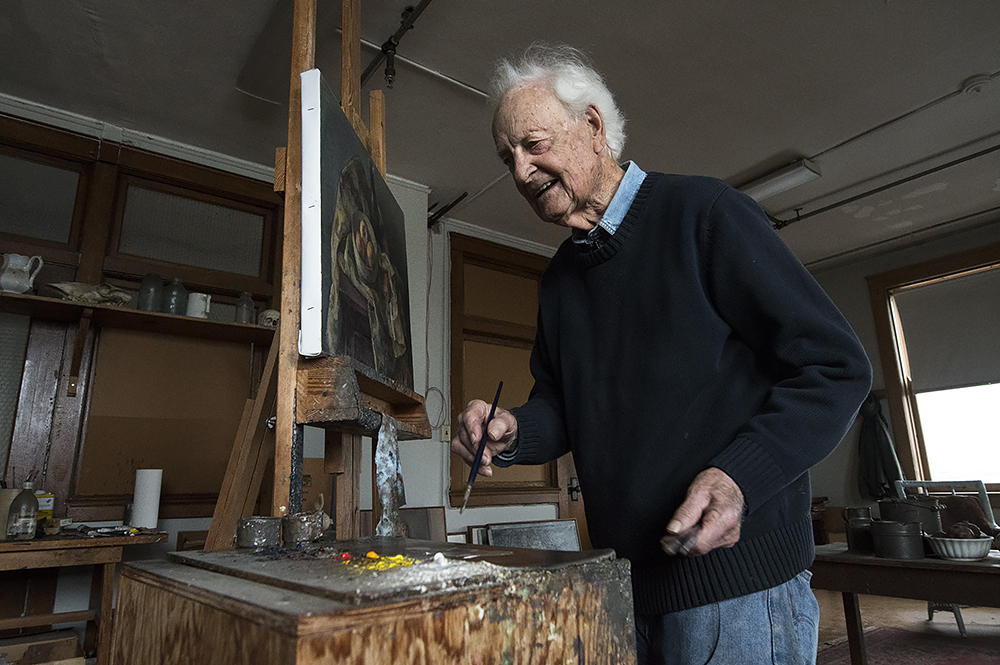By Julie Denesha • Apr 7, 2017
KCUR
Whether they realize it or not, many Kansas Citians have probably seen Wilbur Niewald’s paintings. They might even have seen the artist at a canvas in one of the city’s parks.
“He’s kind of entwined in the fabric of Kansas City,” says Bill Haw, Jr., who opens two shows of Niewald’s work at Haw Contemporary this weekend. “You’ll see his paintings in so many places once you start looking. You’ll see them in people’s living rooms and in corporate collections and in museums.”
Julián Zugazagoitia, the director of the Nelson-Atkins Museum of Art, keeps one of Niewald’s paintings in his office. He calls Niewald “the patriarch of the Kansas City art world.”
“It is one of my great privileges as director to have a wealth of choices for artwork in my office,” Zugazagoitia says, “and I have chosen Wilbur’s ‘Aspen,’ an abstract which he painted in the 1960s while working with lines and undertones of color to create a dynamic sense of space. It is an uplifting piece that brings me much joy every day.”
What brings Niewald joy every day is painting.
At 92, he still spends six hours a day, six days a week dabbing paint on canvas either outdoors or in his studio in the Livestock Exchange Building, where paintings lined up on racks and propped up against walls reveal the subjects he returns to again and again: pine trees at Loose Park, West Bottom landscapes, still life and the occasional nude.
“Fifty feet from Wilbur’s studio, you can smell turpentine, linseed oil and it’s just like you’re walking into this whole other world,” says Haw, adding that the building’s fifth floor was left unfinished so it would be affordable for artists.
Niewald moved in after he retired as chair of the painting and printmaking department at the Kansas City Art Institute. That was 25 years ago.
When KCUR recently paid him a visit, Niewald was dressed in his trademark blue shirt, blue cotton sweater and blue jeans, contemplating a still life he’d been working on for the past month. It’s a bowl of apples and a glass bottle arranged on a table.
“The apple that we’re looking at is kind of going to the rotten side, I guess,” Niewald said. “I may have to replace that apple.”
Niewald abandoned abstraction in 1970. For the past five decades, he’s painted strictly from direct observation. Getting as close as possible to what he sees is Niewald’s goal.
“The subject stimulates you and that’s the emotion,” says Niewald. “The emotion becomes not some idea. The emotion becomes an experience of what you’re seeing.”
Niewald says some people think it’s easy to paint this way, but it’s not.
“It kind of amuses me. Sometimes a person will say, you know, I don’t want to just copy nature, copy what you see. And usually it comes from someone who has no idea how impossible that is,” Niewald says.
“You have to believe in what you see,” he adds. “It becomes the truth and then you try to conform to that. You don’t try to express yourself or your emotions. You just do what is honest to you.”
Niewald was just ten when he took his first art lesson at the Kansas City Art Institute. His work has received accolades over the years, including a prestigious Guggenheim Foundation fellowship in 2006. In January, Niewald had a solo show of twenty four recent paintings at the New York Studio School in Greenwich Village.
For his show at Haw, these works will be joined by several abstract paintings from the 1950s and 60s.
“This time it’s really going to tell a story,” says Haw. “You’re going to be able to walk through the galleries and hopefully kind of see how it kind of started out as completely abstract and then you walk into the big room and suddenly it’s all representational style that people see today.”
Haw says the thing he most admires about Niewald’s painting is their understated beauty.
“There’s no flashiness and no kind of embellishment the way that Wilbur paints it,” Haw says. “And so it kind of sneaks up on you.”
Despite three major shows already this year: one in New York and two exhibits this month at Haw, Wilbur Niewald is not necessarily focused on his legacy.
“A lot of the meaning of painting for me it’s the moment of doing it,” Niewald says. “In other words the real pleasure is in the act of learning, discovering and being satisfied maybe to have realized something.”
Wilbur Niewald’s Recent Paintings and Works from the ’50s and ’60s, through May 6 at Haw Contemporary, 1600 Liberty St, Kansas City, Missouri, 64102. Opening reception, 6-9 p.m. April 7. Due to bridge closings near the West Bottoms, visitors may want to consult posted detours ahead of time.
Julie Denesha is a freelance photographer and reporter for KCUR. Follow her @juliedenesha.
